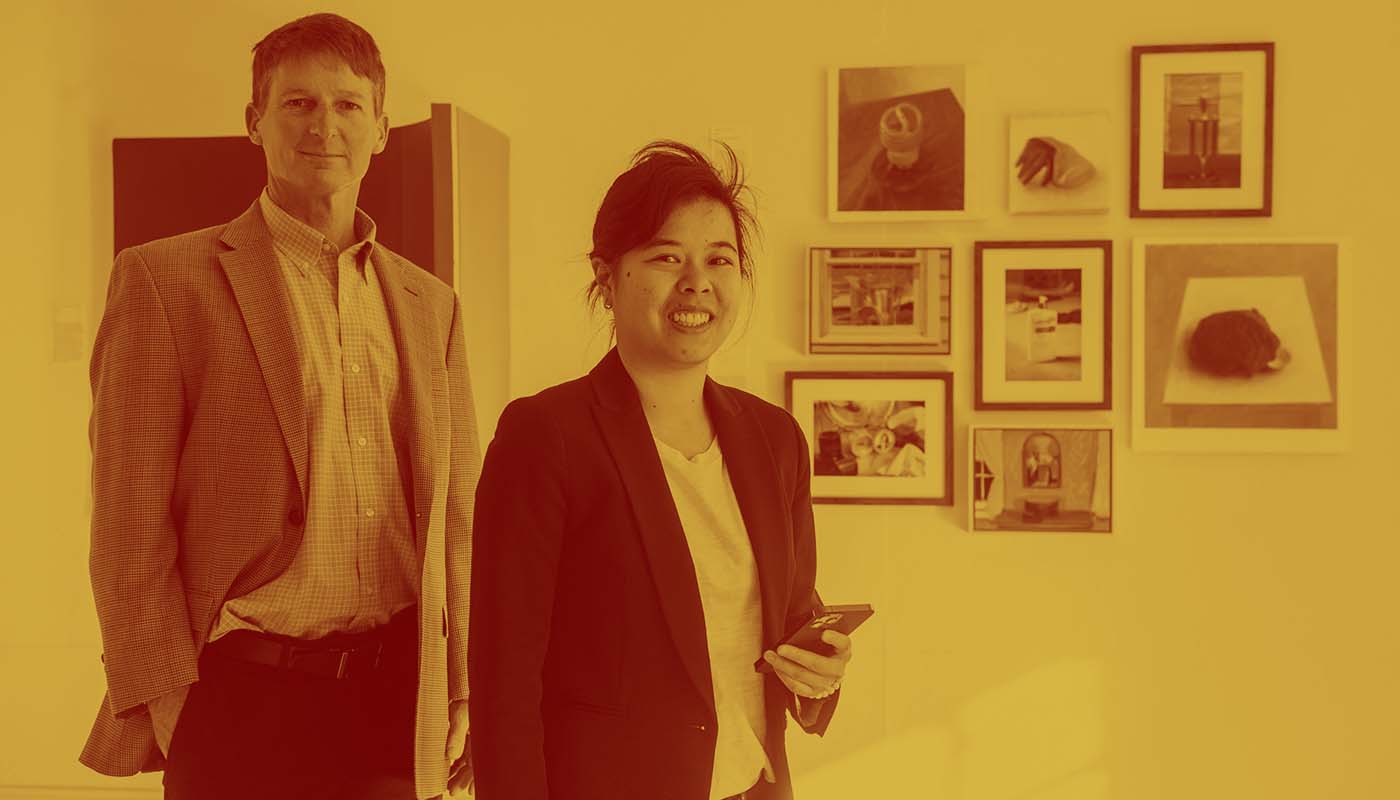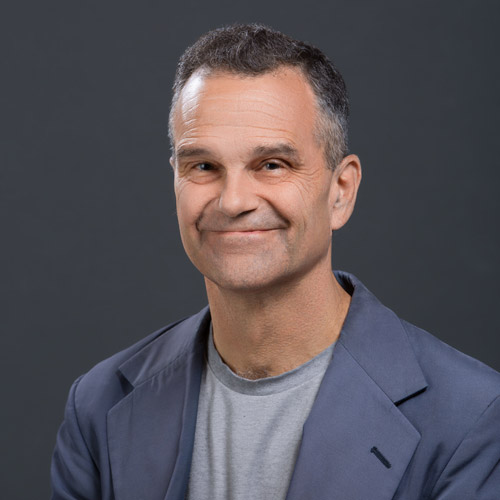My Big Idea: Guided Tours through Virtual and Real Spaces

Emily Lam (ENG’14,’16,’20) and ENG Professor Thomas Little started tech company Rtangent, whose technology provides virtual tours led by a a live interpreter/guide. Photo by Cydney Scott.
Guided Tours through Virtual and Real Spaces
Rtangent, founded by Emily Lam (ENG’14,’16,’20) and ENG’s Tom Little, marries virtual and actual reality to tour museums, galleries, historical sites, trade shows
In our My Big Idea series, we bring you interviews with BU alums and other members of the University community who have launched a business, built a new product, or solved problems big and small. We ask them how they got the idea, what were their biggest stumbling blocks, and what’s next for their big idea.
Rtangent is a tech start-up that—to borrow Star Trek’s futuristic lingo—is a mind meld of virtual reality (VR) and augmented reality (AR). Rtangent’s technology allows people to tour museums and other venues on- or off-site, accompanied by live guides in real time. The firm is the brainchild of cofounders Emily Lam (ENG’14,’16,’20), the company’s CEO, and Thomas Little, a College of Engineering professor of electrical and computer engineering.
They gave Bostonia a demo with one of the venues that will use Rtangent, the USS Constitution, berthed at the Charlestown Navy Yard in Boston. We used a Zoom link on a desktop computer, but you can just as easily use a handheld device. The tour—in this case, with Little and Lam the live guides—offered panoramic, 360-degree photographic images, on deck and below, of the world’s oldest ship still afloat. It afforded a look at the ship’s magazine, a tiny room accessible by a crawl space that you cannot see during in-person tours, Lam says.
With a click on their screens, tourists also can see text and photo panels with information about a venue and its treasures. (For younger kids, some venues offer historically informative online games.)
“My daughter was applying to colleges during the pandemic,” Little says, “and she attended virtual college tours, which consisted of listening to an admissions person give a PowerPoint talk. And they were just painfully dull. What we really wanted to do was allow your interpreter…to tell the story, and also to increase the amount of engagement by individuals.”
Q&A
With Emily Lam and Thomas Little
Bostonia: What exactly is Rtangent? Does your technology require a VR headset?
新兴市场
Bostonia: How many venues use your technology besides the Constitution?
Emily Lam: Thomas Little: We started in April 2020. We have approximately 20 sites developed or in development. Boston-area sites also include the Paul Revere House; the Tsongas Industrial History Center and Boott Cotton Mills Museum, both in Lowell; Gallery 263 in Cambridge; and BU’s College of Fine Arts. You can sign up and take a tour at the Paul Revere House and soon at other well-known sites in the Boston area. We will post links when they are launched by our customers—very soon. We have static (nonguided) sites associated with exhibits at Gallery 263 in Cambridge, but we think the guided tours are where it’s at.
Bostonia: Has the pandemic restrained or bolstered your business?
Emily Lam: Little: COVID caused a pivot from our original plans, but we are designing our platform for what happens next. The world is changing, and there is a lot of opportunity to meet the needs of the new normal in the workplace.
In many ways, the pandemic helps us, because we’re providing a technology that allows you to visit these museums without incurring the risk of COVID. An obvious question is, why should someone invest in a virtual experience if, in six months, we’re not going to be in COVID? Currently, the only way you’re going to enjoy the Constitution is to come to Boston. But imagine the folks who might want to have this ability to visit a historical site without all the travel. This has a huge impact on local schools. If you’re from a community like Lowell, and you want to come to Boston to visit a museum, the logistics, cost, and loss of time to be in classes are pretty large.
Bostonia: Can you give us your elevator pitch—what differs Rtangent from competitors that would make customers want to use your firm?
Emily Lam: Lam: We can increase access to your venue by shifting tours online. We have a unique ability to provide interpreter-led tours that include both interactive guide and individual participant control. Rtangent retains the interpreter in tours, an essential part of the museum/gallery experience. We partner with clients to meet participant goals and provide a mix of tech, art, instructional design, and project management. We’re woman-owned. And kids love the virtual experiences.
Our development trajectory extends past the pandemic, for seamless in-person or virtual access to smart spaces, retaining the value of the virtual experience in the physical place.
Bostonia: How did you fundraise to start the company?
Emily Lam: Little: We started this during the pandemic, and there was no strong source of funding at that time. Our strategy was to work on a shoestring and invest our time as a way to bring this up, rather than money. Our goal is to build a sustainable company that can grow independently and do the right things for these organizations that are paying us, and deliver custom-built experiences.
Bostonia: How many employees do you have?
Emily Lam: Lam: Two, and interns. Our demand for engagements is growing; this is a moving target.
Bostonia: What mistakes did you make in starting Rtangent? What did you learn from them?
Emily Lam: Little: We rushed an initial prototype into our pitch that was not quite ready. It is good to crawl before you walk. We’re over that.
Bostonia: What advice do you have for someone who wants to launch their own business, but maybe doesn’t know where to start? Do you have any advice for BU students who might want to be entrepreneurs, and for their professors and families in encouraging them?
Emily Lam: Lam: Find early partners in your target market who are sympathetic to your goals and can provide candid feedback on your ideas. Watch out for the gap between what you can envision and what people are willing to pay for.
Bostonia: BU and others are making a push to get more women into STEM. How did you originally get interested?
Emily Lam: Lam: I was one of those success stories of outreach programs of the ’90s. I went to engineering camp as a kid; studying it since fifth grade, I was exposed to what I could do, and that set the path forward.


Comments & Discussion
Boston University moderates comments to facilitate an informed, substantive, civil conversation. Abusive, profane, self-promotional, misleading, incoherent or off-topic comments will be rejected. Moderators are staffed during regular business hours (EST) and can only accept comments written in English. Statistics or facts must include a citation or a link to the citation.